Cat (feral or wild)
Common name: Cat (feral or wild)
Scientific name: Felis catus
Origin: Europe, Africa and Asia
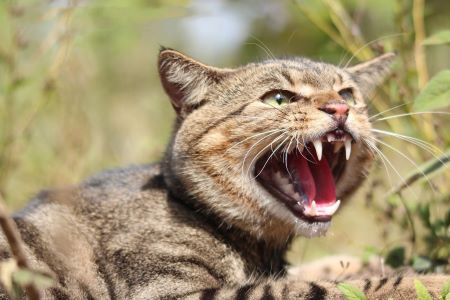
Cats (feral or wild) are a declared established pest species on specified Crown land in Victoria under the Catchment and Land Protection Act 1994 (CALP Act). This declaration came into effect on 26 July 2018.
The declaration applies to areas of Crown land managed by the Department of Energy, Environment and Climate Action (DEECA), Parks Victoria, Phillip Island Nature Park and the four Alpine Resort Management Boards.
Read more about the feral cat declaration.
Read more about the classification of invasive animals in Victoria.
Populations
History of spread
Cats may have arrived in Australia as early a the 17th century, although it is believed that European settlers brought them out as pets during the late 18th century. Cats were also deliberately released into the wild during the 19th century to control rabbits and mice. Today, feral cats exist over much of Australia and have successfully colonised most habitats.
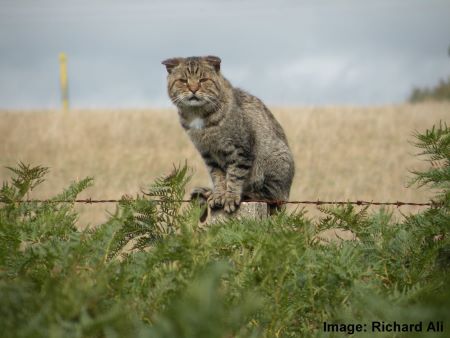
Distribution and population density in Victoria
Feral cats are widely distributed throughout Victoria including several offshore islands.
It is difficult to accurately estimate feral cat populations due to their cryptic behavioural patterns and the changing environmental conditions. When prey is abundant, cat populations may increase rapidly, but when food becomes scarce, they typically decrease. Feral cats usually reach their highest densities on small islands or in human-modified habitats, such as farms and rubbish tips as resources are often abundant in these environments. Feral cats have been shown to move into areas burned by bushfires, where surviving native species are at greater risk of predation through a reduction in sheltering understorey vegetation.
Animal biology
Appearance
In appearance, feral cats can be difficult to distinguish from domestic cats. They have agile bodies, acute senses and fine coordination that is well suited for hunting.
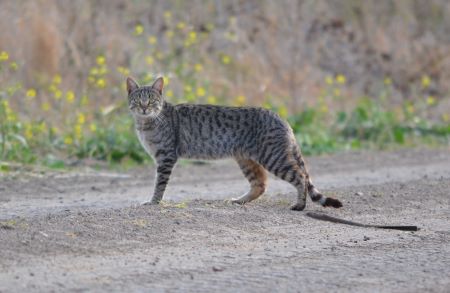
It is common for feral cats to grow larger than most domestic cats with adult males normally weighing from 3.4 to 6.4kg (average weight 4.5kg) and adult females from 2.4 to 4.4kg (average weight 3.2kg).
The most common coat colour of feral cats in Australia is striped tabby, but blotched tabby and black are also common. Other colour variants such as ginger or grey, are also seen in feral cats.
Some deliberately bred characteristics of domestic cat breeds, such as very long coats or flat faces, are not common in feral cats. Readily distinguished breeds of domestic cat, such as Persian or Siamese, are not found in feral populations.
Behaviour
Feral cats are mostly solitary and they tend to be most. active around sunrise and sunset. During the day, feral cats tend to lay up in sheltered areas, including rabbit burrows, hollow logs, or dense thickets of scrub.

In Victoria, feral cat home ranges can vary between <1 km2 and 10km2 if food resources are scarce with males typically having larger home ranges than females.
In rural and bushland environments, feral cats are generally found in low numbers with relatively large home ranges. Where food is more abundant, such as peri-urban areas, feral cat numbers tend to be higher with smaller home ranges.
Diet
Feral cats are opportunistic predators that eat a wide range of wildlife species. They often hunt and kill the most available prey species, but it has been reported certain individuals can become specialist hunters that target specific prey.
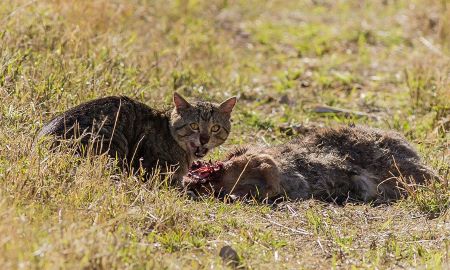
Dietary studies have shown that wild rabbits are a major food item for feral cats in Victoria. However, mice, smaller native mammals, reptiles, birds and invertebrates are also common prey. When live prey is scarce, feral cats will also scavenge food scraps and consume carrion.
Preferred habitat
Feral cats live in a diverse range of habitats including deserts, forests, coastlines, woodlands, grasslands and urban/peri-urban environments.
Diseases and parasites
Feral cats can carry the same parasites and viruses that affect domestic cats, such as roundworms, tapeworms and feline enteritis, feline leucopaenia and cat flu. Cats are the primary host for some parasites and bacteria that can infect people, wildlife and livestock, including Toxoplasma gondii and Sarcocytis and the bacterium that causes cat scratch disease. Feral cat populations contribute to the maintenance and spread of diseases caused by these agents, particularly through excretion of parasite eggs in their faeces.
Reproduction
Feral cat populations are self-sustaining, with reproductive success driven by resource (food) abundance. On average, females have two litters per year with the first in spring and the second in late summer/ early autumn. However, litters can be born in any month with litter sizes ranging from 2 to 7.
Kittens and juvenile feral cats may be prey for foxes, wild dogs/dingoes, reptiles and wedge-tailed eagles, and there is a high natural mortality rate for kittens. Under favourable conditions, feral cat offspring remain with the mother until approximately 7 months of age. After this time, they will gradually leave the family group. Dispersing individuals tend to live a more solitary existence.
Feral cats may live for up to 7 years.
Impact
Impact on ecosystems and biodiversity
Feral cats directly affect native species through predation, disease transmission and resource competition. They may also increase the impacts of other threats to biodiversity, such as bushfire and land clearing.
Feral cats are implicated in the extinction of 25 native, small and medium-sized mammal species and further threaten the survival of over 100 other native species in Australia.
It is difficult to place a dollar value on the environmental impacts of feral cats. Estimates of the annual predation impact by feral cats on Australian native wildlife suggest 272 million birds, 470 million reptiles, 815 million mammals are killed, with unquantified losses of invertebrates and amphibians.
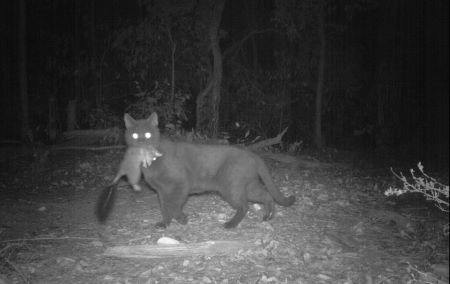
Impacts on agricultural production and human health
There are five pathogens in Australia with known impacts on human health or livestock production, for which cats are the primary host.
The most significant of these is Toxoplasma gondii, a protozoan parasite that reproduces in cats but can be passed to humans and livestock via cat faeces. Infection with T. gondii can lead to significant health effects in people and is a major contributor to spontaneous abortion in sheep and goats.
Estimates of the overall cost of cat-dependent (including both feral and domestic cats) diseases in Australia range from AU$7.67–18.3 million in livestock production losses (from toxoplasmosis and sarcocystosis), and a potential range of AU$2.11–10.7 billion annually in negative effects on human health (from toxoplasmosis and cat scratch disease).
Management
Feral cat control is implemented by department and agency staff, and their agents, to ensure efforts are targeted toward protecting the threatened wildlife most at risk of predation by feral cats. Feral cat control methods that may be applied by department and agency staff include:
- habitat manipulation
- exclusion fencing
- confinement (cage) trapping
Read more about the Humane cage trapping of cats.
- shooting, noting that recreational hunting of pest animals on Crown land does not extend to feral cats, unless being conducted by accredited volunteer shooters engaged to participate in control programs managed by Parks Victoria or DEECA
- leg-hold trapping under Ministerial permit.
Read more about the Leg-hold trapping of declared feral cats.
- PAPP baiting
Read more about the PAPP bait for feral cat control.
Feral cats are not declared as an established pest animal on private land in Victoria, therefore farmers and other private landholders are not required to control feral cat populations on their land.
Farmers can manage feral cats that are found at large near livestock on their land (i.e. among confined animals or in the vicinity of tethered animals) under Section 30 of the Domestic Animals Act 1994. Control using firearms that immediately kills the cat would be considered a suitable method, if it is done humanely and safely.
Other landholders can manage cats roaming on their land (if found trespassing more than once) in accordance with current laws relating to cage trapping.
Any cats trapped on private land must be handed to the local council, so they can be scanned and returned to their lawful owner. Cats without identification must be managed by a council pound or shelter in accordance with the Code of Practice for the management of dogs and cats in shelters and pounds.
Image credits
Figure 1 courtesy of Andrew Cooke
Figure 2 courtesy of Richard Ali
Figure 3 courtesy of Jason Wishart
Figure 4 courtesy of Tony Buckmaster
Figure 5 courtesy of Joe Scanlon
Figure 6 courtesy of Marika Maxwell
Further reading
- Bradshaw, C.J.A., Hoskins, A.J., Haubrock, P.J., Cuthbert, R.N., Diagne, C., Leroy, B., et al. (2021) Detailed assessment of the reported economic costs of invasive species in Australia. NeoBiota. 67:511 - 50.
- Doherty, T.S., Davis, R.A., van Etten, E.J., Algar, D., Collier, N., Dickman CR, et al. (2015). A continental‐scale analysis of feral cat diet in Australia. Journal of Biogeography. 42(5):964-75.
- Doherty, T.S., Dickman, C,R, Johnson, C.N., Legge, S.M., Ritchie, E.G. and Woinarski, J.C. (2017). Impacts and management of feral cats Felis catus in Australia. Mammal Review. 47(2):83-97.
- Fisher, P., Algar, D., Murphy, E., Johnston, M. and Eason, C. (2015) How does cat behaviour influence the development and implementation of monitoring techniques and lethal control methods for feral cats? Applied Animal Behaviour Science. 173:88-96.
- Johnston, M., Algar, D. (2020) Glovebox Guide for Managing Feral Cats. PestSmart Toolkit publication The Centre for Invasive Species Solutions, Canberra, ACT. https://pestsmart.org.au/wp-content/uploads/sites/3/2021/03/CISS-Glovebox-Guide-Cat-web-1.pdf
- Legge, S., Taggart, P.L., Dickman, C.R., Read, J.L. and Woinarski, J.C.Z. (2020). Cat-dependent diseases cost Australia AU$6 billion per year through impacts on human health and livestock production. Wildl. Res. 47(8):731-46.
- Stobo‐Wilson, A.M., Murphy, B.P., Legge, S.M., Caceres‐Escobar, H., Chapple, D.G., Crawford, H.M. et al. (2022). Counting the bodies: Estimating the numbers and spatial variation of Australian reptiles, birds and mammals killed by two invasive mesopredators. Diversity and Distributions. 28(5):976-91.
- Threat Abatement Plan for Predation by Feral Cats (2015). Commonwealth of Australia. Accessed 30 November 2022.
- Feral cat information on the PestSmart website. Accessed on 20 April 2022.